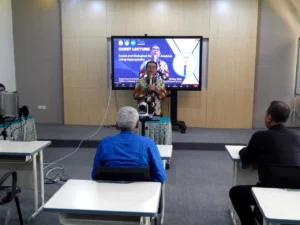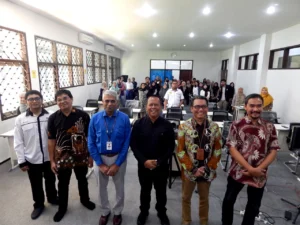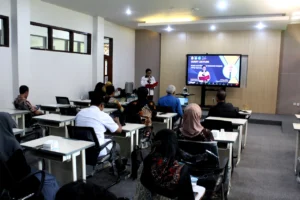 Mathematics Department, FMIPA UNEJ, held a guest lecture with the theme “Social and Biological Networks Analysis using Hypergraph” in the International Lecture Room (13/5). As a resource person, Prof. Dr. V. Swaminathan from the Faculty of Mathematics, School of Arts, Sciences, Humanities, and Education, SASTRA, is deemed to be a university in Thanjavur, India. Present at the Guest Lecture: Prof. Drs. Bambang Kuswandi, M.Sc., Ph.D., Vice Chancellor for Planning, Cooperation, and Information Systems UNEJ, accompanied by the Dean of FMIPA, Prof. Drs. Dafik, M.Sc., Ph.D. In opening the event, Prof. Bambang invited all participants to take part in the event and be able to discuss more about Hypergraph.
Mathematics Department, FMIPA UNEJ, held a guest lecture with the theme “Social and Biological Networks Analysis using Hypergraph” in the International Lecture Room (13/5). As a resource person, Prof. Dr. V. Swaminathan from the Faculty of Mathematics, School of Arts, Sciences, Humanities, and Education, SASTRA, is deemed to be a university in Thanjavur, India. Present at the Guest Lecture: Prof. Drs. Bambang Kuswandi, M.Sc., Ph.D., Vice Chancellor for Planning, Cooperation, and Information Systems UNEJ, accompanied by the Dean of FMIPA, Prof. Drs. Dafik, M.Sc., Ph.D. In opening the event, Prof. Bambang invited all participants to take part in the event and be able to discuss more about Hypergraph.
“Guest Lecture participants can discuss a lot with Prof. Swaminathan to gain new knowledge according to the theme, and UNEJ and his institution will collaborate in the future,” said Vice Chancellor IV while opening the event. Previously, the Dean of FMIPA, Prof. Dafik, expressed his gratitude for the support of the UNEJ rectorate at the Guest Lecture event and for offline and online participants being able to follow and interact with the speakers. “Thank you for the support of Prof. Bambang, the head of UNEJ, who supports this activity, and Prof. Swaminathan, who took the time to share knowledge with us at this guest lecture,” said Prof. Dafik.
Prof. Swaminathan, at the beginning of the material presentation, introduced network analysis. Network analysis is the study of relationships or connections between entities.represented as nodes in a system. “In the social sciences, it helps understand patterns of interaction, influence, and communication between individuals or groups. In biological sciences, it helps in modeling gene interactions, protein-protein networks, and neural connections,” he initially said. Network analysis provides insight into the structure, dynamics, and behavior of complex systems.
Touching on the advantages of applying hypergraphs in network analysis, Prof. Swaminathan made several points. Among them are modeling high-level relationships, expressiveness and flexibility, capturing multimodal data, improved analysis of high-level structures, and efficient representation of complex systems. “The application of hypergraphs in network analysis will create scalability and performance, as well as interpretability and insight,” he explained.
Documentation of Guest Lecture
Prof. Swaminathan also explained the application of hypergraphs to social networks, including several examples. “Hypergraph analysis can reveal hidden community structures and influential users within Facebook friendship networks,” he continued. In biological applications, it is also very useful. These include investigating gene regulation, protein-protein interactions, and metabolic pathways. Drug discovery and development involve identifying drug targets, predicting drug effects, and optimizing drug combinations. “In medical biology, treatment is personalized to adjust treatment based on individual genetic disease tissue,” he said.
Prof. Swaminathan draws the conclusion that hypergraphs can provide a comprehensive representation of high-level dependencies, uncover hidden patterns and structural characteristics, understand network dynamics and behavior, further exploration and research in hypergraph analysis, interdisciplinary collaboration for innovation, the development of new algorithms and tools, and have a have a potential impact in areas such as public health and social policy. At the end of the event, a question-and-answer session was opened with moderator Abduh Riski, S.Si., M.Si., one of the lecturers at the Mathematics Department, FMIPA UNEJ.




